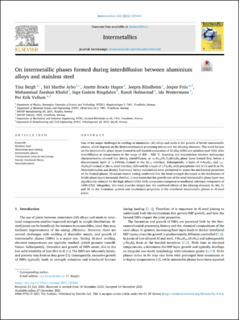| dc.contributor.author | Bergh, Tina | |
| dc.contributor.author | Arbo, Siri Marthe | |
| dc.contributor.author | Hagen, Anette Brocks | |
| dc.contributor.author | Blindheim, Jørgen | |
| dc.contributor.author | Friis, Jesper | |
| dc.contributor.author | Khalid, Muhammad Zeeshan | |
| dc.contributor.author | Ringdalen, Inga Gudem | |
| dc.contributor.author | Holmestad, Randi | |
| dc.contributor.author | Westermann, Ida | |
| dc.contributor.author | Vullum, Per Erik | |
| dc.date.accessioned | 2022-04-04T08:35:41Z | |
| dc.date.available | 2022-04-04T08:35:41Z | |
| dc.date.created | 2022-01-07T08:49:37Z | |
| dc.date.issued | 2022 | |
| dc.identifier.issn | 0966-9795 | |
| dc.identifier.uri | https://hdl.handle.net/11250/2989448 | |
| dc.description.abstract | One of the major challenges in welding of aluminium (Al) alloys and steels is the growth of brittle intermetallic phases, which depends on the thermomechanical processing history and the alloying elements. This work focuses on the intermetallic phase layers formed in roll bonded composites of Al alloy 6082 and stainless steel 316L after interdiffusion at temperatures in the range of 400 – 550 °C. Scanning and transmission electron microscopy characterisation showed that during interdiffusion, an αc-Al15(Fe,Cr,Mn)3Si2 phase layer formed first, before a discontinuous layer of τ1-FeNiAl9 formed at the Al-αc interface. Subsequently, a layer of θ-Fe4Al13 and τ11-Al5Fe2Si formed at the αc-steel interface, followed by a layer of η-Fe2Al5 with precipitates rich in Cr and Si or Ni. Nanoindentation and density functional theory calculations were performed to assess the mechanical properties of the formed phases. Miniature tensile testing confirmed that the bond strength decreased as the thicknesses of brittle phase layers increased. Further, it was found that the growth rate of the total intermetallic phase layer was significantly reduced for the high alloyed 6082-316L composites compared to unalloyed reference composites of 1080-S355. Altogether, this work provides insight into the combined effects of the alloying elements Si, Mn, Cr and Ni on the formation, growth and mechanical properties of the interfacial intermetallic phases in Al-steel joints. | en_US |
| dc.language.iso | eng | en_US |
| dc.publisher | Elsevier | en_US |
| dc.rights | Navngivelse 4.0 Internasjonal | * |
| dc.rights.uri | http://creativecommons.org/licenses/by/4.0/deed.no | * |
| dc.subject | Nanoindentation | en_US |
| dc.subject | Density functional theory | en_US |
| dc.subject | Transmission electron microscopy | en_US |
| dc.subject | Intermetallic phases | en_US |
| dc.subject | Aluminium-steel joining | en_US |
| dc.subject | Stainless steel | en_US |
| dc.title | On intermetallic phases formed during interdiffusion between aluminium alloys and stainless steel | en_US |
| dc.type | Peer reviewed | en_US |
| dc.type | Journal article | en_US |
| dc.description.version | publishedVersion | en_US |
| dc.rights.holder | © 2021 The Authors. Published by Elsevier Ltd. | en_US |
| dc.source.pagenumber | 11 | en_US |
| dc.source.volume | 142 | en_US |
| dc.source.journal | Intermetallics (Barking) | en_US |
| dc.identifier.doi | 10.1016/j.intermet.2021.107443 | |
| dc.identifier.cristin | 1976277 | |
| dc.relation.project | Notur/NorStore: nn9158k | en_US |
| dc.relation.project | Notur/NorStore: nn9722k | en_US |
| dc.relation.project | Norges forskningsråd: 237900 | en_US |
| dc.relation.project | Norges forskningsråd: 197405 | en_US |
| dc.relation.project | Norges forskningsråd: 245963 | en_US |
| dc.source.articlenumber | 107443 | en_US |
| cristin.ispublished | true | |
| cristin.fulltext | postprint | |
| cristin.qualitycode | 1 | |

